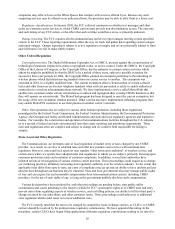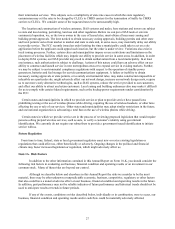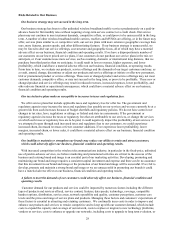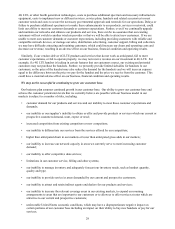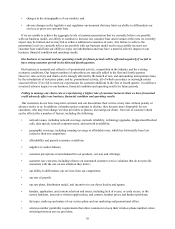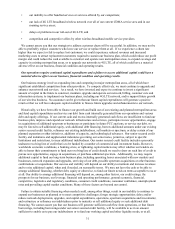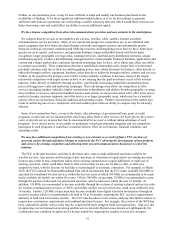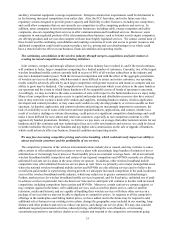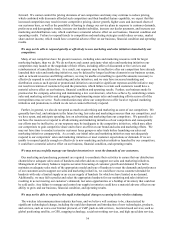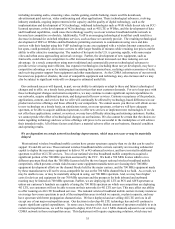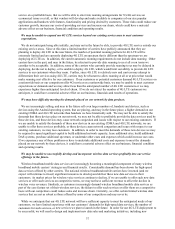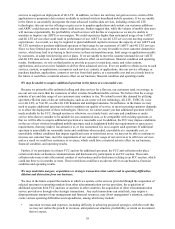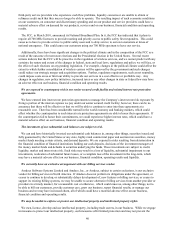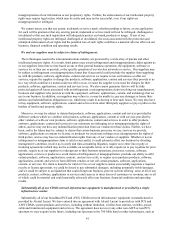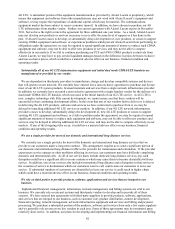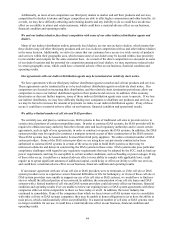Metro PCS 2010 Annual Report Download - page 44
Download and view the complete annual report
Please find page 44 of the 2010 Metro PCS annual report below. You can navigate through the pages in the report by either clicking on the pages listed below, or by using the keyword search tool below to find specific information within the annual report. 34
forward. We cannot control the pricing decisions of our competitors and many may continue to reduce pricing,
which combined with discounts afforded such competitors and their bundled feature capability, we expect that this
increased competition may result in more competitive pricing, slower growth, higher costs and increased churn of
our customer base, as well as the possibility of having to change our service plans in response to customer demands,
preferences and demographic trends, increase our handset subsidies, increase our dealer payments, and increase our
marketing and distribution costs, which could have a material adverse effect on our business, financial condition and
operating results. Failure to respond timely to competition and marketing strategies could reduce revenue, market
share and net income, which would have a material adverse effect on our business, financial condition and operating
results.
We may not be able to respond quickly or effectively to new marketing and sales initiatives launched by our
competitors.
Many of our competitors have far greater resources, including sales and marketing resources with far larger
marketing budgets, than we do. We do not know and cannot anticipate what sales and marketing initiatives our
competitors may launch or the magnitude of their efforts, including offers of discounted or free services and
reimbursement of cancellation fees. As a result, our response may be ineffective after our competitors have already
launched their sales and marketing initiatives, may be delayed by longer lead-time elements in our business system,
such as network resources and billing software, we may be unable or unwilling to spend the amounts necessary to
effectively respond to such new marketing and sales initiatives, and we may have increased marketing and
distribution costs as such special or promotional initiatives can result in significant expenses and the initiative may
not result in retention of customers beyond the promotion, which failure to retain such customers would have a
material adverse effect on our business, financial condition and operating results. Further, our business model is
premised on the company achieving and maintaining a low cost structure, which we achieve by centralizing certain
sales and marketing activities and designing and implementing major sales and marketing efforts across all of the
metropolitan areas we serve. Such centralization may allow our competitors to offer local or regional marketing
initiatives and promotions to which we do not or cannot effectively respond.
Further, in general, we also do not spend as much on advertising and marketing as some of our competitors. We
generally have had, and anticipate in the future having, less sales and marketing resources than our competitors, and
we have spent, and anticipate spending, less on advertising and marketing than our competitors. We generally do
not have the resources to respond to all advertising and marketing initiatives of our competitors and consequently
our efforts may be ineffective, or our response may be inadequate to the competitive initiatives, which may allow
our competitors to gain competitive share and to have an effect on our brand and sales and marketing efforts. We
may not have time to conduct extensive customer focus groups or sales trials before launching our sales and
marketing initiatives companywide. As a result, our initial sales and marketing initiatives may not adequately
respond to our competitors’ sales and marketing initiatives or meet customer expectations or demands. If we are
unable to respond quickly enough or effectively to new marketing and sales initiatives launched by our competitors,
it could have a material adverse effect on our business, financial condition, and operating results.
We may not successfully manage our handset inventories to meet the demands of our customers.
Our marketing and purchasing personnel are required to coordinate their activities to ensure that our distribution
channels have adequate sales stock of handsets and other add ons to support our sales and marketing initiatives.
Management of inventory balances requires accurate forecasting of customer growth and demand. If we fail to
maintain an adequate sales stock of the appropriate model and type of handsets to meet the demands and preferences
of our customers and to support our sales and marketing initiatives, we could have excess customer demand for
handsets with only a limited supply or an excess supply of handsets for which we have limited or no demand.
Additionally, we may fail to predict and select the appropriate handsets for our marketing and sales initiatives
resulting in us not meeting our customer’s demands, lost sales opportunities or a buildup of inventory that could not
be sold easily. Any failure to manage and control our supply inventories could have a material adverse effect on our
ability to grow and our business, financial condition, and operating results.
We may not be able to respond to the rapid technological changes occurring in the wireless industry.
The wireless telecommunications industry has been, and we believe will continue to be, characterized by
significant technological change, including the rapid development and introduction of new technologies, products,
and services, such as voice-over Internet protocol, or VoIP, push-to-talk services, location-based services, such as
global positioning satellite, or GPS, mapping technology, social networking services, and high speed data services,




